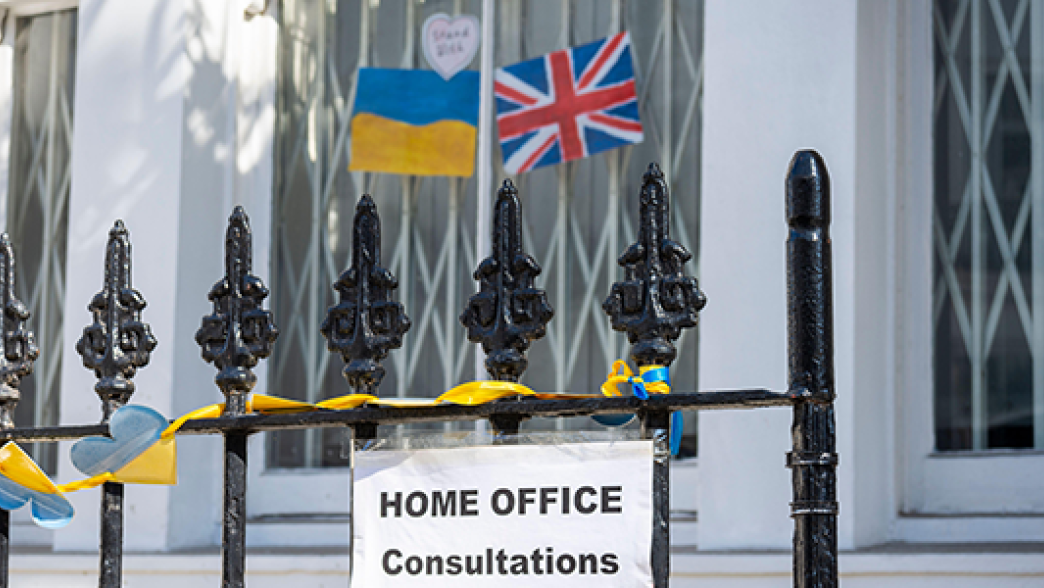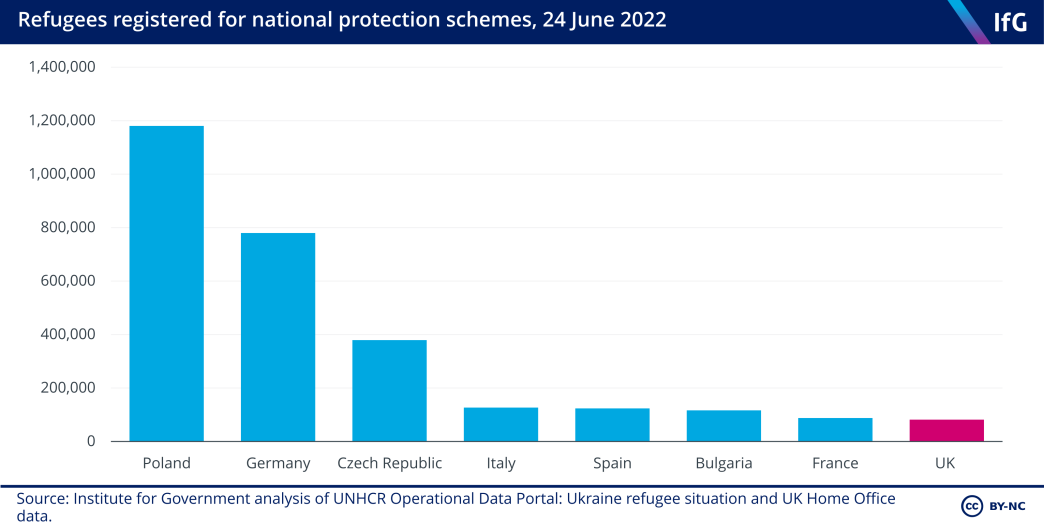Ukraine crisis: UK support for refugees from Ukraine
The UK has announced two new pathways through which Ukrainian refugees can obtain a visa to come to the UK.

Russia’s invasion of Ukraine has caused the worst refugee crisis in Europe since the Second World War. The UN estimates that as of late June, 3.5m refugees from Ukraine are registered for temporary protection in Europe. [1]
As the Ukrainian government is currently not permitting men aged 18-60 to leave the country, most of these refugees are women and children. The United Nations Human Rights Commissioner (UNHCR) has declared a level three emergency, its highest level.[2]
The EU removed visa requirements for Ukrainian citizens to enter the Schengen area in 2017. Ireland, which is an EU member but not in the Schengen area, lifted visa restrictions for Ukrainian nationals on 25 February 2022, the day after Russia’s invasion of Ukraine.[3]

Do Ukrainian refugees still need visas to come to the UK?
Yes. Prior to the start of the war all Ukrainian citizens required a visa to enter the UK, and this has not changed.
How can Ukrainian refugees obtain a visa to come to the UK?
The UK has announced two new pathways through which Ukrainian refugees can obtain a visa to come to the UK.
The Ukraine Family Scheme, launched on 1 March. This is open to Ukrainian nationals who have family members who are British citizens or are settled in the UK. This includes immediate family (partners, parents and children) and extended family (grandparents, siblings, uncles, aunts, cousins, nephews and nieces).
The Homes for Ukraine scheme, launched on 14 March and open for applications from 18 March. This scheme is open to all Ukrainian nationals who are currently outside the UK and were resident in Ukraine before 1 January 2022 (and their immediate family, who may be of other nationalities).
At present under the Homes for Ukraine scheme, Ukrainian nationals need a resident in the UK to act as a sponsor. There is currently no UK resettlement scheme for refugees from Ukraine who are not Ukrainian nationals.
How many visas have been issued under the schemes?
As of 21 June, the Home Office reported that a total of 135,900 visas had been issued – 43,200 through the Ukraine Family scheme and 92,700 through the Homes for Ukraine scheme. 82,100 refugees have so far arrived in the UK.[4]
What rights will Ukrainian refugees receive in the UK?
Ukrainian refugees who come to the UK under these two schemes will receive a visa giving them the right to remain for an initial period of three years. They will have the right to work, to receive public funds such as Universal Credit, and access to public services such as schools and health care.
What role do sponsors play in the Homes for Ukraine scheme?
UK residents can register as named sponsors for Ukrainian refugees wishing to come to the UK. Sponsors undertake to provide free accommodation to a Ukrainian individual or a family for a period of at least six months. Sponsors receive a monthly payment of £350 from the government.
Will the UK government match refugees to potential sponsors?
The UK government is not currently doing so. In England and Northern Ireland, charities, NGOs, faith groups and other organisations are trying to match Ukrainian refugees with sponsors so that they can apply for visas. People or organisations who do not have a named individual they wish to sponsor can register their interest with the government. The UK government has said that it will be working closely with civil society organisations “to ensure people who want to help are matched to people from Ukraine.”[5]
The Scottish and Welsh governments have taken on the role of “super-sponsor” for Ukrainian nationals under the Homes for Ukraine scheme. This enables Ukrainian refugees to receive visas without a named individual sponsor and receive temporary accommodation in Scotland and Wales while the respective governments work with local partners to provide longer term accommodation. Ultimately, the Scottish government intends to provide support through this approach to 10% of the total number of Ukrainian nationals who receive asylum in the UK.[6] As of early June, the Welsh government had issued 2,000 issues through the ‘super-sponsor’ scheme.[7]
Some UK refugee organisations are establishing strategic partnerships with counterparts in EU countries to facilitate larger groups to come to the UK, where local UK organisations can provide them with accommodation.
What steps are in place to protect and support refugees arriving through this scheme?
Although the UK government is not currently taking a coordinating role in identifying sponsors for Ukrainian refugees, it conducts checks of potential hosts before visas are issued. The Home Office conducts criminal record and Warning Index checks on all sponsors. Local councils conduct basic Disclosure and Barring Service (DBS) checks for all adults in the sponsor households. When the refugee families include children or vulnerable adults, enhanced DBS checks are conducted.
The government is providing £10,500 to councils per person settled through the scheme in the first year to enable them to support refugees and help them integrate into the community.[8]
Are there limits on the number of people who can use the scheme?
No, there is currently no upper limit on the number of people who can come to the UK under this scheme. On 21 March, Sajid Javid, the secretary of state for health and social care, said that “I expect that we will see hundreds of thousands of Ukrainians arrive here in the UK, and they will get all the support that they need.” [9] In the initial days after the Homes for Ukraine scheme was launched, over 150,000 people expressed an interest in hosting Ukrainian refugees on the government website.[10] However, the government has stated that “only some of these will ultimately become sponsors.”[11]
In practice, the need for Ukrainian applicants to be matched with a named sponsor is a constraint on the number of people who can apply through the scheme. The level of uptake will depend on whether civil society organisations, or the UK government itself, are able to scale-up a coordinated system for matching potential UK sponsors with Ukrainians seeking asylum, and to make this system widely available and accessible to Ukrainian refugees.
What criticism has been made of the scheme?
NGOs and politicians have been critical of the government’s decision not to lift the visa regime. They argue this would bring the UK in line with the immigration rules of other European countries and expedite the resettlement of Ukrainian refugees to the UK. The current scheme puts heavy demands on the immigration services to process visas. NGOs have also criticised the level of bureaucracy involved in the process.
The Refugee Council has noted that by establishing a visa route and sponsorship scheme, the initiative “will inevitably be restricted to those who are known to people in the UK and be a quite complex lengthy visa application process. A humanitarian crisis requires a speedy and compassionate response not one that puts bureaucratic hurdles ahead of the immediate needs of people whose lives have been ripped apart.”[12]
In a letter to the prime minister, the Scottish first minister said: “It is neither reasonable nor morally acceptable to expect people fleeing war to go through complex bureaucratic processes in order to reach safety within the UK. Therefore, we urge you to follow the example of European countries including the Republic of Ireland by waiving all visa requirements for any Ukrainian nationals seeking refuge in the UK, as well as implementing the temporary protection regulations.”
The Labour Party has called for the government to reduce the bureaucracy of the scheme and establish a formal central system for matching people. However, it has so far not called for the visa requirement to be lifted.[13]
The government has said that the visa process ensures that vital security and biometric checks are conducted and that these will remain in place. Priti Patel, the home secretary, has suggested that Russian operatives, and extremist groups and organisations could take advantage of a visa-free system to enter the UK. On 19 March, Patel said that: “The processes that we have put in place closely follow the advice of our intelligence and security services. They mean we can help Ukrainians in need, without making our country less safe.” [147]
How does this scheme compare to other resettlement schemes?
The UK operates three ongoing resettlement schemes, all of which are small in scale: the UK Resettlement Scheme (UKRS), the Community Sponsorship Scheme, and the Mandate Resettlement Scheme. The UK Resettlement Scheme is accessible to refugees who have been assessed for resettlement by the UNHCR against their resettlement submission categories, within limits set by government funding commitments and local government capacity.[15] The Community Sponsorship Scheme allows community groups to sponsor and resettle people recognised as refugees by the UNHCR. The Mandate Resettlement Scheme allows recognised refugees to join close family members in the UK who are willing to accommodate them.
The UK has introduced a number of targeted resettlement schemes in the past in response to specific humanitarian crises.
In April 2021, the government established the Afghan Relocations and Assistance Policy. According to provisional data, more than 7000 people have been relocated so far under the scheme. A separate Afghan Citizens Resettlement Scheme opened in January 2022.[16]
In 2015 the government announced that the Syrian Vulnerable Persons Resettlement Scheme would aim to 20,000 Syrians in need of protection by 2020. The government met its resettlement target in February 2021.[17]
In 2021, 1,587 people were settled in the UK through existing resettlement schemes.[18]
- https://data.unhcr.org/en/situations/ukraine
- www.unhcr.org/uk/ukraine-emergency.html
- www.gov.ie/en/press-release/00aef-minister-mcentee-announces-immediate-lifting-of-visa-requirements-between-ukraine-and-ireland/#:~:text=The%20Minist…
- www.gov.uk/government/publications/ukraine-family-scheme-application-data/ukraine-family-scheme-and-ukraine-sponsorship-scheme-homes-for-ukraine-visa…
- www.gov.uk/guidance/homes-for-ukraine-scheme-frequently-asked-questions
- https://spice-spotlight.scot/2022/03/21/welcoming-ukrainians-to-the-united-kingdom/
- https://gov.wales/update-homes-ukraine-scheme
- www.gov.uk/guidance/homes-for-ukraine-guidance-for-councils
- www.theguardian.com/politics/2022/mar/21/hundreds-of-thousands-of-ukrainian-refugees-poised-to-enter-uk-says-sajid-javid
- www.gov.uk/government/speeches/work-and-pensions-secretary-topical-statement-homes-for-ukraine
- www.gov.uk/register-interest-homes-ukraine
- https://refugeecouncil.org.uk/latest/news/homes-for-ukraine-scheme-refugee-council-response/?doing_wp_cron=1648075829.4673910140991210937500
- www.theguardian.com/world/2022/mar/20/homes-for-ukraine-sponsorship-scheme-beset-by-unworkable-bureaucracy
- www.conservatives.com/news/2022/spring-conference-2022--address-from-home-secretary-priti-patel
- https://assets.publishing.service.gov.uk/government/uploads/system/uploads/attachment_data/file/1011824/Resettlement_Policy_Guidance_2021.pdf
- www.gov.uk/government/statistics/immigration-statistics-year-ending-december-2021/how-many-people-do-we-grant-asylum-or-protection-to
- www.gov.uk/government/publications/uk-resettlement-schemes-factsheet-march-2021/vulnerable-persons-and-vulnerable-childrens-resettlement-schemes-fact…
- www.gov.uk/government/statistics/immigration-statistics-year-ending-december-2021/how-many-people-do-we-grant-asylum-or-protection-to
- Topic
- Policy making
- Keywords
- Immigration Foreign affairs
- Publisher
- Institute for Government